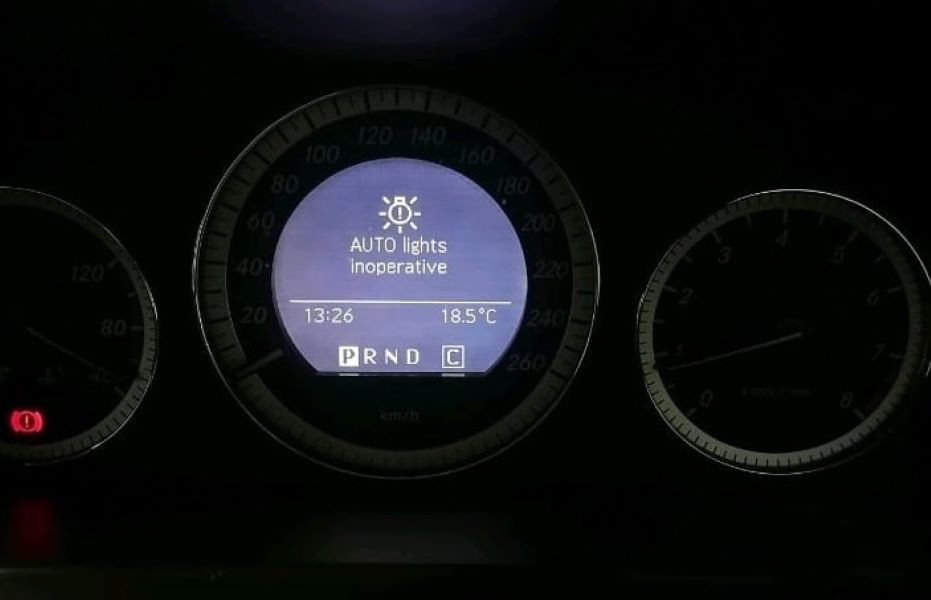Table of Contents
Auto Lights Inoperative: Meaning, Causes & Fixes for Mercedes-Benz
If your Mercedes shows the “Auto Lights Inoperative” warning, the automatic headlight and rain-sensing functions have malfunctioned. While manual lighting still works, this can compromise safety and convenience.
In this guide, we’ll walk you through the typical causes of auto light malfunctions in Mercedes vehicles and share quick troubleshooting steps to help you restore full lighting function. Whether you’re facing a simple sensor fault or something more complex, we’ll help you get your headlights back on track.
Common Causes & Symptoms
| Cause | Symptoms | Recommended Action |
|---|---|---|
| Faulty light & rain sensor | Auto light and wiper functions inoperative; associated warning appears | Replace and program a new Sensor (LRSM); requires coding |
| Sensor installed but not programmed | Warning remains even if the new sensor works part-time | Use Mercedes diagnostic tool (e.g. XENTRY) to adapt sensor |
| Wiring or connection issue | Intermittent failure or no sensor signal | Inspect harness around mirror/rain‑light module, reseat connectors |
| Headlamp module or control error | May cause related functions failure, especially in adaptive headlights | Scan SAM or headlamp module for communication faults and repair/replace |
Diagnostic & Repair Flow
- – Perform diagnostic scan (e.g. XENTRY) to retrieve fault codes like U141E‑00 (illumination switch), B221D‑49 (rain sensor), B225F‑46 (light sensor).
- – Check mirror-mounted LRSM: verify tight connector, correct orientation, clean windshield.
- – Add a new sensor? After replacement, adapt/configure it via Mercedes diagnostic system.
- – If issue persists inspect wiring near mirror and headlamp: check for chafing or poor contacts.
- – If headlamp modules are involved, evaluate and repair/replace communication modules.
- – Clear faults, test auto function by covering sensor/light or wetting windshield, and verify operation.
Case Study: Auto Lights Inoperative in a Mercedes-Benz C300
Complaint: Auto lamp function inoperative and No Auto Rain Sensing
A Mercedes-Benz C300 W204 came into the workshop with a warning on the dashboard: Auto Lights Inoperative. This issue not only affected the automatic lighting but also the rain-sensing functionality, leaving the vehicle’s safety systems compromised.

Diagnostic Process:
Upon receiving the vehicle, I began with a thorough diagnostic check. The scan revealed multiple fault codes:
- – U141E-00: An implausible signal from the switch exterior illumination was received, indicating a general failure.
- – B221D-49: The rain sensor had a malfunction, pointing to an internal electrical fault.
- – B225F-46: The light sensor also had a malfunction, with a similar internal electrical fault.


These fault codes highlighted a deeper issue affecting both the light and rain sensors, leading to the Auto Lights Inoperative warning.
Investigation:
Using the wiring diagram, I carefully checked the power supply and resistance of the relevant wires. All the connections were intact, and the wiring seemed to be in good condition. This led me to suspect that the issue lay within the sensor components themselves.
Solution:
Given the internal faults in both the light and rain sensors, I decided to replace the entire component integrating these sensors. After the replacement, I rechecked the system, and I am pleased to report that everything is now working perfectly. The Auto Lights Inoperative warning has been cleared, and both the automatic lighting and rain-sensing functions are fully operational.

This case study highlights the importance of attention to detail in automotive diagnostics. The Auto Lights Inoperative warning may seem like a minor inconvenience, but it can significantly impact vehicle safety.
By carefully diagnosing and addressing the underlying faults, we can ensure that our vehicles remain safe and reliable. Always double-check to prevent such issues from recurring!
DIY vs. Professional Tasks
| Task | DIY-Friendly | Professional Recommended |
|---|---|---|
| Scan and clear fault codes | Yes | — |
| Visually inspect LRSM module | Yes | — |
| Replace sensor or headlamps | Moderate | Technician required for proper coding |
| Access or repair wiring/connectors | Moderate | Specialist to trace electrical faults |
| Replace headlamp modules (adaptive) | No | Dealer or certified workshop strongly advised |
How does my car know when it’s raining?
Your car knows when it’s raining thanks to the rain sensor, a device that detects moisture on the windshield. Here’s how it works:

1. Infrared Light Reflection:
- – The rain sensor, typically mounted behind the rearview mirror on the windshield, uses infrared (IR) light. The sensor emits an infrared beam at an angle onto the windshield glass.
2. Detection of Rain:
- – Under normal conditions (when the windshield is dry), most of the IR light is reflected back into the sensor, creating a certain intensity of reflected light.
- – When raindrops hit the windshield, they disrupt this reflection. The more water droplets on the windshield, the less IR light is reflected back to the sensor. The sensor detects this decrease in reflected light intensity.
3. Activation of Windshield Wipers:
- – Based on the amount of IR light reflected back, the sensor determines the amount of rain on the windshield. If the reflected light drops below a certain threshold, indicating rain, the sensor sends a signal to the car’s control system to activate the windshield wipers.
- – The wiper speed can also adjust automatically depending on the intensity of the rainfall, ensuring optimal visibility.
This technology allows the vehicle to react almost instantly to changes in weather conditions, enhancing safety and convenience by automatically managing the windshield wipers without requiring driver input.
What is light and rain sensor?
The light and rain sensor in a vehicle is a combined sensor that performs two key functions:

1. Light Sensor:
- – The light sensor automatically detects the ambient light level outside the vehicle. When it gets dark (e.g., at dusk or in a tunnel), the sensor signals the vehicle’s lighting system to turn on the headlights and other necessary lights. This feature enhances safety by ensuring the lights are activated without the driver needing to do so manually.
2. Rain Sensor:
- – The rain sensor is responsible for detecting moisture on the windshield. When it starts to rain, the sensor triggers the windshield wipers to activate automatically. The sensor can also adjust the wiper speed based on the intensity of the rain, providing optimal visibility without the driver having to adjust the wiper settings.
These sensors are often integrated into the windshield, typically near the rearview mirror, and work together to improve the convenience and safety of driving in varying light and weather conditions.
How to tell if a car has a rain sensor?
To tell if a car has a rain sensor, you can look for the following signs:

1. Check the Windshield Area Behind the Rearview Mirror:
- – Rain sensors are usually mounted on the windshield behind the rearview mirror, often in a small, darkened area. Look for a small, rectangular or square-shaped module attached to the windshield. This is often visible from outside the car as well.
2. Automatic Wiper Function:
- – If your car has an “Auto” or “Automatic” setting on the windshield wiper control, it likely has a rain sensor. When set to “Auto,” the wipers should start on their own when it begins to rain.
3. Vehicle’s Owner’s Manual:
- – The owner’s manual of the car will typically list whether a rain sensor is part of the vehicle’s features. Look under sections related to windshield wipers, automatic features, or rain sensors.
4. Check for Sensor Markings:
- – Some cars have markings or a label on the windshield near the sensor module indicating the presence of a rain sensor.
5. Test the Wipers:
- – You can test for a rain sensor by using a spray bottle to mist the area of the windshield where the sensor is located. If the wipers activate automatically, your car has a rain sensor.
These methods should help you determine if your car is equipped with a rain sensor.
Frequently Asked Questions
Can I still drive safely with this warning?
Yes, you can use manual headlights but auto lighting and rain-sensing features will not work. Replace sensor soon.
Will the message go away by itself?
No. If it resurfaced after installing a new sensor without programming, the system still isn’t recognised.
Does replacing the sensor fix it?
Only if the sensor is **physically compatible**, installed properly, **and adapted/coded** via Mercedes diagnostics utility.
Could while changing bulbs cause this?
Rare, it’s usually tied to the LRSM module or mirror bezel wiring. Bulb changes generally don’t affect it directly.









Leave a Reply